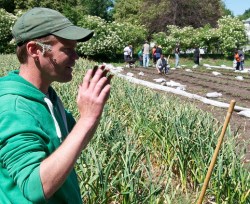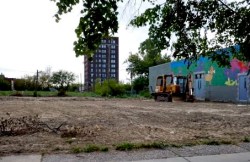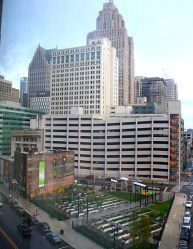
Same BeebeThe author at work as an urban farmer.
I moved to Detroit almost 10 years ago, largely because I was interested in learning more about the city’s burgeoning community gardens. At the time, little media interest was being paid to Detroit or its urban agriculture movement, and it certainly was not a place folks were looking to for the future of city gardening.
Not long after my arrival, my sister hit me with a sucker punch of a question: “Don’t you ever worry that your work in community gardening is contributing to gentrification?”
I vehemently denied her charges, but in the back of my mind I had already been turning over the question, and feared that she might be right. Over the years, her question has stuck with me, and it seems especially pressing now, as development in Detroit is ramping up. Proposals for a light rail system, construction of a high-end grocery store, and the rehabbing of luxury lofts all have folks wondering where this will lead. Some see it as Detroit’s rebound, others worry that rents will begin to skyrocket and the working class will be driven out.
Looking at the Detroit landscape, there is still so much empty land, and so many vacant buildings, it can often be difficult to imagine gentrification even happening. I’ve met people who say “a little gentrification would be a good thing for Detroit.”
I disagree.
There are things that can and need to change about the city, but change in a neighborhood is often organic — one group of people finds themselves in better economic situations and moves on. Gentrification is systematic; it involves the displacement of people against their will. City governments use economic incentives to attract higher-income people and the businesses that cater to them. Rents and property taxes go up, and those who have historically lived in a community have no choice but to move elsewhere.
Gentrification should not be confused with community development — or neighborhood improvement, through organizing and hard work by the members of that community. Places like the South Bronx, Harlem, the South Side of Chicago, and the Mission District in San Francisco have all been improved drastically by hard-working neighborhood activists only to see them increasingly vulnerable to gentrification as conditions improve.
Urban agriculture can be a force for good in under-resourced neighborhoods. It can provide job training, access to healthy food, and it has also recently been linked — in one study at least — to reduced crime rates. But many of the people of color I have known and worked with say it also inevitably attracts young white people, which — while not necessarily the cause of gentrification — is often a sure sign that it’s on the way.

Patrick Crouch Detroit’s Birdland garden before it was bulldozed.
Frank Donner was part of a garden in Detroit which was recently bulldozed to make room for a parking lot. The garden was started around 2003, and over the years Donner saw major changes. “The garden stabilized some vacant land, attracted the eye of people passing by who were interested in flowers and fruit trees,” he recalls. It also served as a community gathering spot. “There were a lot more people stopping by and asking questions.”

Patrick Crouch The same garden before it was paved over to make a parking lot.
The business that would eventually take over the garden’s lot opened in 2005. It was at times supportive — it was willing to provide water to the garden — but, Donner says,”I don’t think the owner ever really got what we were doing.” When he started seeing “white women in sports bras jogging in the evening,” he knew that the neighborhood was well on its way to being gentrified. It wasn’t long after that the lot was bought by the business next door and the hard and painful task of digging up fruit trees, grape vines, and other perennials began.
There are many factors that can cause a neighborhood to change, and the community garden was only one of “a variety of reasons the neighborhood was ripe for gentrification,” adds Donner. For one, it was conveniently located near downtown Detroit. He points to another garden, called the Georgia Street Garden (on the east side of Detroit), as an exception.
“Georgia Street is doing a lot for the community but is never going to contribute to gentrification.” It’s also located far away from the central business district, from good jobs, and from the area’s major highways.
Karen Washington is an urban farmer from the Bronx who helped start the community garden across the street from her house — The Garden of Happiness — in 1988.
“You had people who wanted to take back their community and got together and turned those empty lots into gardens. For me it was the first community organizing experience, going into these lots, cleaning them out, and starting to grow,” Washington explains.
Initially, she says the community garden movement was a means to take pride in and feel a sense of ownership in low-income neighborhoods. While growing food was important, it was secondary to the desire to push drug dealers out, stop illegal dumping, and create a little beauty in areas that were battling blight and absentee landlords.
Washington points to Brooklyn neighborhoods like Bushwick and Park Slope, which have both seen a great deal of gentrification in recent years. “As the complexion of the community changed, so has the complexion of the community gardens.” Rather than seeing these gardens as a cause of the shift, Washington sees it in reverse. “Gentrification was the cause of seeing more of a white presence in the community gardens,” she says.
But the shift away from community gardens toward scaled-up, more food-focused, often for-profit urban farming is a different story.
“You have this new yuppie group coming in that is gung ho about urban agriculture … but the movement wasn’t about urban agriculture, it was about survival, taking back our communities,” she says. “Now you have people coming into gardens that have established histories, that were built on the backs of people who made it safe for you to come in, and you’re gonna talk about urban agriculture? You cannot leave out … the history and the legacy of the elders who were there long before so you can do whatever you wanna do.”
Washington makes an important point. In recent years, the media seems to have shifted the spotlight from community gardens to urban farms. We see an increase in portrayals of young, white urban farmers on rooftops using expensive hydroponic systems. Because there’s often a profit motive, it’s easier to justify the land use to city officials and developers because it can mean jobs and economic development, thus bringing new value to that land, and making those communities ripe for gentrification.
It won’t surprise you to hear that, as a young white person who manages an urban farm, I’m still left wondering about my role in gentrification. The projects I’ve worked with don’t seem to have increased property values and forced people out of the neighborhood, but I can’t say the same for the impact of other current, or proposed future, projects. Could my work contribute to a neighborhood that is one day filled with luxury lofts, rather than the rehabbed houses and affordable housing it needs? And are those concerns a reason not to act, to try to make a difference in the first place? Probably not.
I moved to Detroit not because I had answers, but because I had questions. I moved not into one of the hip neighborhoods, but what I would call “real Detroit” — far off the beaten path for any New York Times photographers; a middle class/lower income African-American neighborhood. My wife and I were some of the only white folks around. I had neighbors who spent hours schooling me in the history of the neighborhood, Detroit, urban farming and gardening, racism in the community, and much, much more. I spent what felt like months just exploring the city, volunteering at community gardens, sharing tea on stoops and meals with all sorts of folks while listening to their stories.
Over time, Detroit became home. I found myself more invested in the work, and developing more of a leadership role in the urban farming world. This opened me up to criticism. People I greatly respected started questioning the proliferation of white people in leadership roles in the Detroit “food movement.” I admit to recoiling a bit, feeling defensive, but it would have been wrong not to face these critiques. So I listened to my critics’ concerns, and talked with them about how I could address them.
In recent years I’ve worked to make changes at the organization I work with — Earthworks Urban Farm — based on the feedback I heard; we moved our focus toward social justice, and reevaluated our decision-making and hiring processes. We worked to develop a residents and business association that we work closely with. We developed partnerships with groups that were actively promoting justice as their work, and learned more from them. I became a part of a group that sponsored anti-racism trainings in Detroit, and became active in a white anti-racist group. (While gentrification by definition is an issue of class, as long as wealth inequality falls along racial lines, race will be an important piece of the puzzle. Hipsters and artists have often been implicated in gentrification, and while both groups are often diverse in race and class, they are not the beneficiaries of the economic changes of gentrification. The land developers, landlords, and banks are the ones who really benefit, and those groups are most often white.)
Earthworks and I still have a lot of work to do, but we’re doing what we can to make sure urban agriculture is more than just a catalyst for gentrification. We’re rooting our work in the history of growing food in Detroit, and our values are deeply grounded in social justice. We might not be perfect, but we are trying, and that gives me hope.
Are you working in urban agriculture and want to promote social justice too? Here are some suggestions you might find helpful:
- Learn the history of the community you are working in. Understand how it was developed, which indigenous communities lived there before, and what polices shaped it and changed it.
- If you are not from the community you are working in, I recommend spending more time listening — really actively listening — than talking.
- You don’t have to take credit for good ideas to see them enacted. And even if you have some good ideas, don’t assume those ideas haven’t been tried before, or that no one else has had them.
- Seek out established leaders and support them.
- Accept criticism graciously and don’t immediately defend yourself. Take it in and evaluate it slowly.
- Find mentors you trust to help guide you in your work.




